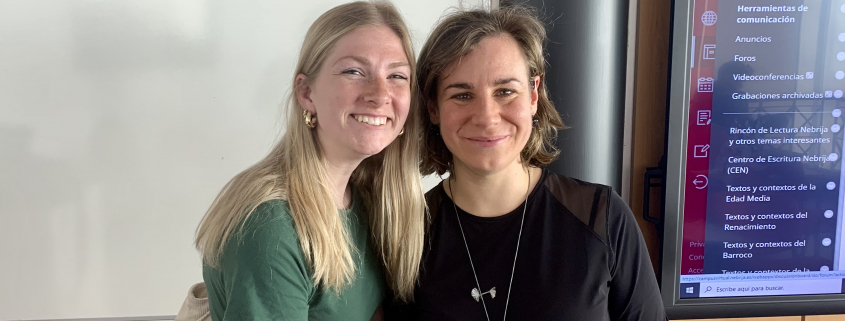Bridging Two Cultures
Living in Spain has taught me many things about Spanish culture, but also about my own and how it may appear to people of other cultures. I had the wonderful opportunity to interview one of my Spanish professors, Ana, who has several years of experience with both the American and Spanish cultures. It was very eye-opening to see my own culture through her eyes and learn more about hers.
Some questions I asked her were about the roles of men and women, her religion, her views on her American students, stereotypes, and much more. Here are a few things I found especially interesting.
Religion: I was curious about her religion since I had previously been told that Spain is primarily Catholic. She mentioned that she has never been baptized or gone to church in her entire life. She commented that this is unusual for Spaniards because most begin their lives in a Catholic church but eventually leave. I was sad that she was not familiar with Jesus’ love for her and had never experienced or heard of the good news of the Gospel, but she was so respectful of all religions and beliefs. This also gave me the brief opportunity to share what my faith was all about. Though brief, I was thankful for the opportunity to tell her about Jesus before moving on to the next topic.
Spanish Stereotypes: One of the first questions I asked Ana was, “What are some stereotypes that you think people have about the Spanish culture?” Her immediate response focused on the Siesta Hora. “Some people think we as a culture are lazy because we build naps into our schedule, but I think it encourages us to be even more productive. Everyone thinks that we are last-minute people, never planning ahead or anything. And while that may be true for some, I love planning ahead and being prepared. Also, being able to work well under pressure and on-the-go is a good trait to have. I see it as a skill.” This is a rough translation since we were speaking in Spanish, but I loved her take on it. I could clearly see that it frustrated her to be grouped into one perspective that believes they all are lazy and never plan. She said she identifies with none of those things. While it is true for some (in any culture), it is not true for everyone. After living in Spain for a couple of months now, I have learned to love the siesta hora. It has also challenged me to be more flexible and “go-with-the-flow.” I don’t have to plan everything out weeks in advance to be organized. I have grown a lot in the sense that I am learning to be okay with last-minute changes and spontaneous plans. I really do appreciate that about the Spanish culture.
American Stereotypes: When I asked what she thought about American culture and some stereotypes that come along with it, I prepared myself for answers such as “They are loud, disrespectful, and have no culture.” However, I was very surprised at her response. Yes, she did compare us to Barbie dolls living in our dream world full of opportunities, but she had so many kind and admirable qualities that she mentioned. For example, she loved that we are so “practical” and focused on the future. She often gets frustrated with European culture, which is so focused on tradition and the past, in her words. Ana had the opportunity to live in the United States and learn English, so she came to have an appreciation for the way America operates. Now that she is living in Spain again, she misses certain aspects of American culture, such as the efficiency and practicality of our way of life. She loves the warm and welcoming personalities of Americans (in general) because it reminds her of her own Spanish culture. She has been teaching international students for many years now, so I asked her about the differences in culture within the classroom. Ana told me about Spanish classroom etiquette, where the teacher speaks and the students listen. The teacher is respected and viewed as above the students. She has noticed that American students like to challenge the teacher and discuss material, something that Ana really appreciates and enjoys. However, American students yawn, eat, stretch, and drink during lectures – all things considered rude in Spain. Overall, Ana’s view of America was overwhelmingly positive, much to my surprise. I loved hearing her perspective and kind words that seemed to bridge our two cultures, showing me that we really are not that different from one another.
One comment that Ana made about Spanish culture is, “We are a country of extremes. You are either with me or against me.” In one sense, it reminded me of the politics in the United States. Everyone seems to be against each other and is very opinionated. In a different sense, the people in Spain are a little more respectful when sharing their opinions on politics, according to Ana. Politics are not often discussed with people who you don’t know very well.
Finally, from one teacher to another (future) teacher, I asked her if she had any advice. Personally, I have been struggling with the idea that maybe I am not meant to be a teacher. I have an interest in so many things that it is hard for me to see myself only being a teacher. Ana gave me great advice. There is a phrase in Spanish, “Las personas son el fin, no el medio.” This was saying that people are the goal, not just the means used to get something that we desire. People are the best possible outcome, not to be used to our advantage. This is why she is a teacher now. She loves creating relationships with students and learning from them. Creating connections with them is why she wants to continue being a teacher. She told me that everyone is different and everyone has something unique to add to their lives. I loved her perspective on this. Ana told me that even though I am unsure of what my future career will be, always to keep learning. Learn from being a teacher, learn from students, learn from any and every experience that I have. As a literature teacher, she also told me to keep reading 🙂
Interviewing Ana was definitely the most beneficial learning experience I have had since arriving in Madrid. I learned things that can’t simply be taught in books and classes but can only be learned from talking to people of different backgrounds and cultures. Not only did I learn so much about my own culture and the Spanish culture, but I was able to make a lasting connection with my professor, Ana.


